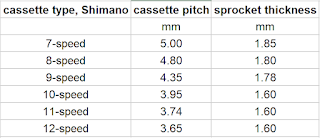Monday, March 4, 2024
Gear shifting - electronic or not?
Friday, February 23, 2024
Indoor trainers or outdoor rides?
It's winter time so some of you are likely still in hibernation mode, which means parking your bike in the garage until it gets warmer again to ride. Others, myself included, will keep riding as long as it's reasonably dry outside (i.e. it's not pouring heavily at the moment). Then, there is a third group that will not ride outside, but use an indoor trainer instead.
I don't like indoor trainers and find them pointless, but I think I understand why they may be an attractive option for some cyclists. I'm guessing that there are at least 3 main technical reasons why someone would use an indoor trainer:
- Bad weather. This one is most obvious. Some people don't like riding when it's cold, icy, snowy, rainy, etc.
- No "winter bike". Some people only have 1 bike (impossible!) and they don't want to expose their nice, expensive bike to road salt, mud, etc.
- No place to properly clean a bike. Some people live in apartments or tighter spaces that lack facilities to clean the bike after a ride. Knowing that I can simply use a garden hose to wash my bike right after, makes me want to ride it more in winter time.
But then there is another, important, philosophical reason why some prefer indoor trainers, while others would never use them. It's the answer to a question - why we ride?
It's basically a difference between racing or more competitive riding and touring or "romantic cycling". You simply need to ask yourself - what's the goal of my riding? If the goal is the destination and you want to get there as fast as you can, then you are racing and in this case your body output and power will be important to you. An indoor trainer will help you stay fit, well-trained and maintain peak performance through those gloomy winter months.
The other answer is - my goal is the journey, the ride itself. The destination is not only secondary, it's actually something unwanted because it ends my ride. I want to travel, see places, take pictures, spend time in nature. In that case an indoor trainer is as useless as two chopsticks to eat a soup. A trainer won't take you to places. You will be stuck in your room, spinning cranks and staring at a wall.
Wednesday, February 14, 2024
Liberating Limitations
We live in interesting times - the times of many opportunities. We have a chance to go to more places than our grandparents ever could. We can do more things, as they are generally more accessible to us. We have more options to buy and own various stuff than before.
And yet, sometimes it feels that this variety, this accessibility, these opportunities are overwhelming. Not that I would like someone to make decisions for myself, but I do get a feeling that less is more and limitations can be... liberating.
Take cameras, for example. I always take one on every bike ride. If I want something small, it's my Ricoh GRIII. If I have space for something larger, it's my Fuji with a 35mm lens. That's it. No multiple choices. No zooms. Small and simple. One focal length to do it all. At first, this looks like a severe limitation. You may think that you need to be able to take ultrawide angle pictures of landscapes and close ups of distant wildlife, all on the same 50 mile trip. No, you don't. It actually better to limit yourself to one focal length and learn how to see the world through just one lens. You won't take all pictures, but you will take some good ones.
Back to bicycles - single-speed bikes are liberating in some sense. Not having to think about gear shifting keeps it simple. You can focus on your ride and surroundings only. Just push on pedals and go. If you can't go - walk your bike uphill. It's not a race and you are not in rush.
If that's too much for you and you really want to keep your gearing, that's fine. It's useful in most situations. However, I found out that those modern, multi-speed systems are not needed to day-to-day riding. Unless you race, there really is no need for a 12-speed cassette and top of the line shifters. In fact, my adventure bike has a simple 2x9 speed setup with friction shifting. That sounds ancient and is not something that most cyclists would be willing to try, but again, it's liberating. It works with any derailleur, from any brand, is cross-compatible with most mechanical components, and is so simple that there is basically no way to break it. I mean, a friction shifter is built of 3 main parts that pretty much can't fail in normal conditions. May not feel or look fancy, but it is in fact a true zombie-apocalypse-ready gearing.
Sometimes it's just not necessary to overcomplicate things!






